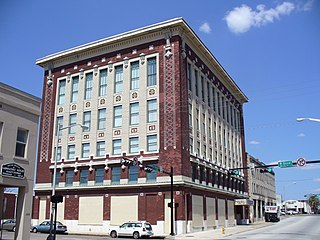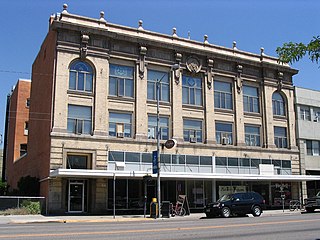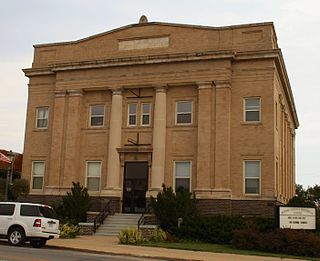
The Masonic Temple is a historic Masonic temple in Jacksonville, Florida. It is located at 410 Broad Street. Constructed by the Grand Lodge between 1901 and 1912, it was added to the U.S. National Register of Historic Places on September 22, 1980.

The Salt Lake Masonic Temple is the Masonic headquarters for Utah, and is Salt Lake City's best example of Egyptian Revival architecture. It was completed in 1927, and is located in the South Temple Historic District of Salt Lake City, Utah, United States.

The Masonic Temple Building located at 133 Fayetteville Street in Raleigh, North Carolina was the state's first reinforced concrete skyscraper. Constructed in 1907 by Grand Lodge of North Carolina, the building represents the growth of Raleigh in the early 20th century and rise of the influence of Masons. The Masonic Temple Building was added to the National Register of Historic Places in 1979 and is a Raleigh Historic Landmark.

The Highland Park Masonic Temple, also known as The Mason Building or The Highlands, is a historic three-story brick building on Figueroa Street in the Highland Park district of northeast Los Angeles, California.

The Masonic Temple Building, built in 1907, is an historic Prince Hall Masonic building located at 427 South Blount Street in Raleigh, North Carolina. It is a three-story, red brick flat roofed building. It has a metal cornice at the top of the first floor level and a cast iron Corinthian order column at the corner. On May 3, 1984, it was added to the National Register of Historic Places.

The Masonic Temple in downtown Casper, Wyoming is a Masonic hall, built in 1914 during a boom time initiated by the development of the Salt Creek Oil Field. Located on a corner site, the temple remains essentially as it was designed by Casper architect Homer F. Shaffer. The four story light-colored brick building rests on a raised basement and is topped by a crenelated parapet. The original windows have been replaced with vinyl units but retain the one-over-one appearance of the originals. Windows extend over the west and south sides. The north side is blank, while the east side is the building's rear facade and has fire escapes and a few windows.

The Landmark Convention Center in Tacoma, Washington, United States is located at 47 St. Helens Avenue. It was added to the National Register of Historic Places in 1993. Ambrose J. Russell is credited as the architect of the meeting hall and theater. It is said to be in a Renaissance style and Late 19th and 20th Century Revival style, and said to have had its "period of significance" between 1925 and 1949.

The Masonic Temple is a historic Masonic building in Philadelphia. Located at 1 North Broad Street, directly across from Philadelphia City Hall, it serves as the headquarters of the Grand Lodge of Pennsylvania, Free and Accepted Masons. The Temple features the Masonic Library and Museum of Pennsylvania, and receives thousands of visitors every year to view the ornate structure, which includes seven lodge rooms, where today a number of Philadelphia lodges and the Grand Lodge conduct their meetings.

The former Masonic Temple is a historic commercial and social building at Main and High Streets in downtown Belfast, Maine. Built in 1877, it is one of the city's most elaborately decorated buildings, featuring Masonic symbols. It was listed on the National Register of Historic Places in 1973. While there are active Masonic organizations in Belfast, they now meet in a modern facility on Wight Street.
The Masonic Temple is a historic Masonic temple located at Warrensburg, Johnson County, Missouri. It was built in 1893–1894, and is a rectangular three-story, Italianate style red brick building with extensive sandstone trim. The building measures approximately 48 feet by 92 feet.

The Masonic Temple was a historic two-story wooden building at 809 1st Avenue, near the Chena River in Fairbanks, Alaska. It was built in 1906, expanded in 1908, and further altered in 1913 and 1916. Its architecture was "eclectic Renaissance Revival", a style that had been popular in the "lower 48" United States in the 1880s and 1890s. It was listed on the National Register of Historic Places in 1980.

The Mount Moriah Masonic Lodge No. 18 is a historic building in Lisbon, Arkansas, US. The two-story wood frame lodge building was built in 1858, and is virtually unaltered. It has several distinctive construction features, including 12" by 12" timber posts that rise the full two stories at its corners; this feature is believed to be unique in the state. It was built as a meeting hall a local chapter of Freemasons, and is the oldest purpose-built Masonic hall still used for that purpose in Arkansas.

The Montrose Masonic Temple in Montrose, Colorado is a historic building constructed in 1911. Built as a meeting hall for Montrose Lodge No. 63, Ancient Free and Accepted Masons, the building is in the Classical Revival style. The Masons met in the upper two of the building's three stories, while the ground floor was rented out as commercial space. Its commercial space has been rented to the Adams Vacuum and Sewing company, to a printing and office supply store, and to a funeral home. The lodge no longer meets in the building. The building was listed on the National Register of Historic Places in 2004.

The Masonic Lodge in Missoula, Montana, is a Beaux Arts building from 1909. It was listed on the National Register of Historic Places in 1990.

The Boone History Center, previously known as the Champlin Memorial Masonic Temple, is a historic building in Boone, Iowa. Constructed in 1907 as the Champlin Memorial Masonic Temple, the building housed Mt. Olive Lodge No. 79 until 1990. It now houses the Boone County Historical Society.

The Old Masonic Hall, also known as Benicia Masonic Hall, is a historic building in Benicia, California. Constructed by Benicia Masonic Lodge No. 5 in summer 1850, on land donated by Alexander Riddell and with lumber donated by Benicia founder Robert Semple, it was the first purpose build Masonic Hall in California. It was occupied by the lodge October 14, 1850, and formally dedicated December 27, 1850.

The name "Pythagoras Lodge No. 41, Free and Accepted Masons" is used by the National Register of Historic Places when referring to a historic building located in Decatur, Georgia. The building is also known as Pythagoras Masonic Temple and occasionally known as Decatur Masonic Temple. Built in 1924, the building is a work of William J. Sayward (1875-1945), an architect who was a member of the Masonic lodge, and who partnered with William A. Edwards in the firm Edwards and Sayward. It was designed and built in Beaux Arts architecture style.

The Asheville Masonic Temple is a Masonic Temple located in Asheville, North Carolina. Designed by British American architect and Freemason Richard Sharp Smith, the building was opened in April 1915. It is listed in the United States National Register of Historic Places as a contributing building in the Downtown Asheville Historic District.




















